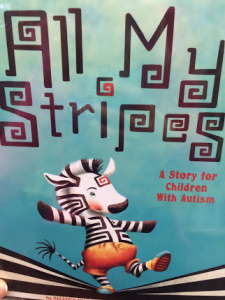
Author: Shawna Rudolph and Danielle Royer
Illustrator: Jennifer Zivon
Publishing Information: Magination Press, 2015
Number of Pages: 34
Genre: Realistic Fiction
Analysis:

All my stripes tells the story of a zebra named Zane, and his experiences with autism in a classroom setting. Zane can tell he is different from his classmates, and begins worry as he feels that they only see his autism stripe (a red stripe on his forehead that indicates he has autism). It isn’t until his mother explains his many other wonderful stripes that Zane learns that his autism stripe is just one of many stripes, and does not define who he is.
This is quite possibly my favorite book of the ones I have analyzed, as it gives children a way to understand autism and the everyday differences and hardships of people who are effected by the condition. For example, it portrays Zane’s distress when the fire alarm sounds, whereas his classmates were able to remain calm and quiet. Also, the author creates a scene in which the classmates cannot understand why Zane wants to use a paintbrush instead of his hoof when doing a painting activity, because Zane does not like the feeling of paint. The back of the book provides an explanation of these scenes, and how they connect to the behaviors of real people with autism. Furthermore, it provides a guide for how caretakers can help to address and aid with these behaviors for their students/child. This provides an excellent door for both children and adults to respond to those with autism in a caring and understanding manner.
The illustrations are unframed, so readers are able to really put themselves in the scene with Zane. One is able to see the distressed look on his face as he shares his concerns with his mother, and is self-conscious around his classmates. I thought it was interesting as well that on the first page when Zane addresses his concerns to his mother, it is raining which can signify the sadness he feels.
Zane’s mother goes on to explain that the autism stripe is not his only stripe, and he has many other wonderful stripes; his “pilot stripe” that makes him good with directions, his “caring stripe” that reflects his concern for others, his “honesty stripe” which reflects his willingness to tell the truth, and his “curiosity stripe” that shows his eagerness to learn. This teaches children that no one aspect of their life defines them, and the value of self-acceptance. Furthermore, they are learning about autism and how to help in a way that they can better understand at a younger age.
